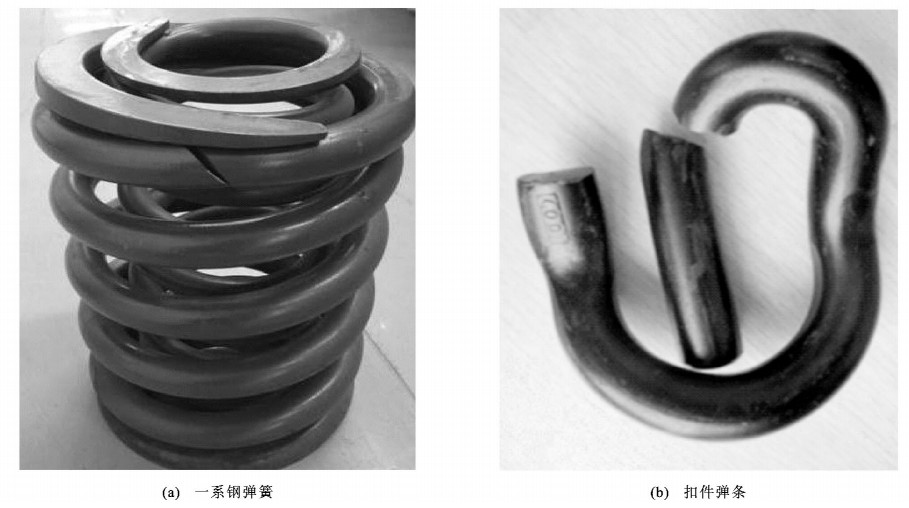Effect of metro rail corrugation on dynamic behaviors of vehicle and track
Article Text (Baidu Translation)
-
摘要: 采用钢轨波磨测量仪测量了钢轨波磨特征, 采用加速度和位移传感器测量了钢轨打磨前后车辆和轨道零部件的振动加速度, 分析了钢轨波磨对车辆和轨道零部件振动的影响, 建立了车辆-轨道耦合动力学模型, 研究了钢轨波磨对轮轨相互作用力的影响, 确定了钢轨打磨限值。研究结果表明: 钢轨波磨主波长为30~40 mm, 次波长为16 mm; 钢轨轨头和弹条在650~800 Hz的振动和轴箱在670~800 Hz的振动与30~40 mm波长对应的车辆通过振动行为一致, 因此, 短波钢轨波磨导致地铁车辆和轨道零部件振动过大, 是车辆一系钢弹簧和轨道扣件弹条疲劳断裂的主要原因; 钢轨打磨可以有效解决疲劳断裂问题, 打磨前钢轨轨头、弹条、轨枕和道床振动加速度均方根分别为243.4、309.3、17.1、2.6 m·s-2, 打磨后振动加速度均方根下降为51.5、8.8、1.5、0.5 m·s-2; 轮轨垂向力和横向力均对钢轨波磨波长非常敏感, 当钢轨波磨波深为0.1 mm时, 35、80 mm波长对应的轮轨垂向力分别为307、109 kN, 横向力分别为56、25 kN; 当车辆运营速度为90~120 km·h-1时, 根据轮重减载率限值标准, 35 mm波长钢轨波磨波深为0.05~0.08 mm, 根据轮轨垂向力限值标准, 35 mm波长钢轨波磨波深为0.03~0.06 mm, 建议30~40 mm短波钢轨波磨波深达到0.05 mm时进行打磨处理。
-
关键词:
- 地铁 /
- 短波钢轨波磨 /
- 车辆-轨道耦合动力学 /
- 钢轨打磨
Abstract: The characteristics of rail corrugation were measured by using corrugation analysis trolley, the vibration accelerations of vehicle and track components were measured by using acceleration and displacement sensors before and after rail grinding, and the effect of rail corrugation on the vibrations of vehicle and track components was analyzed. Vehicle-track coupling dynamics model was established to analyze the effect of rail corrugation on wheel/rail interaction force and to determine the limit value of rail grinding. Study result shows that the main wavelength of rail corrugation is 30-40 mm and the secondary wavelength is 16 mm. The vibrations of railhead and fastener clip at 650-800 Hz and the vibrations of axle box at 670-800 Hz are in accordance with the passing vibration behaviors of vehicle with wavelength of 30-40 mm. So the short-pitch rail corrugation leads to the strong vibration of metro vehicle and track components, and it is the main cause of fatigue fracture of primary suspension springs and track fastener clips. Rail grinding can effectively solve fatigue fracture problem. Before rail grinding the root mean square values of vibration accelerations of railhead, fastener clip, sleeper and ballast bed are 243.4, 309.3, 17.1 and 2.6 m·s-2 respectively, and after rail grinding they decrease to 51.5, 8.8, 1.5 and 0.5 m·s-2 respectively. When the depth of rail corrugation is 0.1 mm, wheel/rail vertical forces are 307 and 109 kN with wavelengths of 35 and 80 mm respectively, and wheel/rail transverse forces are 56 and 25 kN with wavelengths of 35 and 80 mm respectively. So wheel/rail vertical and transverse forces are very sensitive to the wavelength of rail corrugation. When vehicle operation speed is 90-120 km·h-1, the depth of rail corrugation with wavelength of 35 mm is 0.05-0.08 mm according to the limited criterion of wheel unloading rate, and the depth is 0.03-0.06 mm according to the limited criterion of wheel/rail vertical force. So rail grinding should be carried out when the depth of 30-40 mm short-pitch rail corrugation reaches 0.05 mm.-
Key words:
- metro /
- short-pitch rail corrugation /
- vehicle-track coupling dynamics /
- rail grinding
-
表 1 钢轨波磨测试结果
Table 1. Test result of rail corrugation

-
[1] SATO Y, MATSUMOTO A, KNOTHE K. Review on rail corrugation studies[J]. Wear, 2002, 253(1/2): 130-139. https://www.sciencedirect.com/science/article/pii/S0043164802000923 [2] GRASSIE S L. Rail corrugation: characteristics, causes, and treatments[J]. Journal of Rail and Rapid Transit, 2009, 223(6): 581-596. doi: 10.1243/09544097JRRT264 [3] OOSTERMEIJER K H. Review on short pitch rail corrugation studies[J]. Wear, 2008, 265(9/10): 1231-1237. https://www.sciencedirect.com/science/article/pii/S0043164808001439 [4] AHLBECK D R, DANIELS L E. Investigation of rail corrugations on the Baltimore Metro[J]. Wear, 1991, 144(1/2): 197-210. https://www.sciencedirect.com/science/article/pii/004316489190015M [5] TASSILLY E, VINCENT N. Rail corrugations: analytical model and field tests[J]. Wear, 1991, 144(1/2): 163-178. https://www.sciencedirect.com/science/article/pii/004316489190013K [6] TASSILLY E, VINCENT N. A linear model for the corrugation of rails[J]. Journal of Sound and Vibration, 1991, 150(1): 25-45. doi: 10.1016/0022-460X(91)90400-E [7] GóMEZ I, VADILLO E G. An analytical approach to study a special case of booted sleeper track rail corrugation[J]. Wear, 2001, 251(1-12): 916-924. doi: 10.1016/S0043-1648(01)00750-5 [8] DIANA G, CHELI F, BRUNI S, et al. Experimental and numerical investigation on subway short pitch corrugation[J]. Vehicle System Dynamics, 1998, 29(S): 234-245. [9] TORSTENSSON P T, NIELSEN J C O. Monitoring of rail corrugation growth due to irregular wear on a railway metro curve[J]. Wear, 2009, 267(1-4): 556-561. doi: 10.1016/j.wear.2009.01.046 [10] GRASSIE S L, ELKINS J A. Rail corrugation on North American transit systems[J]. Vehicle System Dynamics, 1998, 29(S): 5-17. doi: 10.1080/00423119808969548 [11] WU T X, THOMPSON D J. An investigation into rail corrugation due to micro-slip under multiple wheel/rail interactions[J]. Wear, 2005, 258(7/8): 1115-1125. https://www.sciencedirect.com/science/article/pii/S0043164804003217 [12] JIN X S, WEN Z F, WANG K Y, et al. Three-dimensional train-track model for study of rail corrugation[J]. Journal of Sound and Vibration, 2006, 293(3-5): 830-855. doi: 10.1016/j.jsv.2005.12.013 [13] NIELSEN J C O. Numerical prediction of rail roughness growth on tangent railway tracks[J]. Journal of Sound and Vibration, 2003, 267(3): 537-548. doi: 10.1016/S0022-460X(03)00713-2 [14] JIN Xue-song, WANG Kai-yun, WEN Ze-feng, et al. Effect of rail corrugation on vertical dynamics of railway vehicle coupled with a track[J]. Acta Mechanica Sinica, 2005, 21(1): 95-102. doi: 10.1007/s10409-004-0010-x [15] NIELSEN J C O, EKBERG A, LUNDéN R. Influence of short-pitch wheel/rail corrugation on rolling contact fatigue of railway wheels[J]. Journal of Rail and Rapid Transit, 2005, 219(3): 177-187. doi: 10.1243/095440905X8871 [16] 钟硕乔, 吴磊, 李伟, 等. 钢轨波磨对地铁车辆动力学响应的影响[J]. 计算机辅助工程, 2012, 21(6): 26-30. doi: 10.3969/j.issn.1006-0871.2012.06.006ZHONG Shuo-qiao, WU Lei, LI Wei, et al. Effect of rail corrugation on dynamical response of metro vehicle[J]. Computer Aided Engineering, 2012, 21(6): 26-30. (in Chinese) doi: 10.3969/j.issn.1006-0871.2012.06.006 [17] EKBERG A, KABO E, NIELSEN J C O, et al. Subsurface initiated rolling contact fatigue of railway wheels as generated by rail corrugation[J]. International Journal of Solids and Structures, 2007, 44(24): 7975-7987. doi: 10.1016/j.ijsolstr.2007.05.022 [18] JENKINS H H, STEPHENSON J E, CLAYTON G A, et al. The effect of track and vehicle parameters on wheel/rail vertical dynamic forces[J]. Railway Engineering Journal, 1974, 3(1): 2-16. https://trid.trb.org/view.aspx?id=19226 [19] ZHAI Wan-ming, WANG Kai-yun, CAI Cheng-biao. Fundamentals of vehicle-track coupled dynamics[J]. Vehicle System Dynamics, 2009, 47(11): 1349-1376. doi: 10.1080/00423110802621561 [20] CHEN G, ZHAI W M. A new wheel/rail spatially dynamic coupling model and its verification[J]. Vehicle System Dynamics, 2004, 41(4): 301-322. doi: 10.1080/00423110412331315178 [21] SHEN Z Y, HEDRICK J K, ELKINS J A. A comparison of alternative creep force models for rail vehicle dynamic analysis[J]. Vehicle System Dynamics, 1983, 12(1-3): 79-83. doi: 10.1080/00423118308968725 -





 下载:
下载:
















